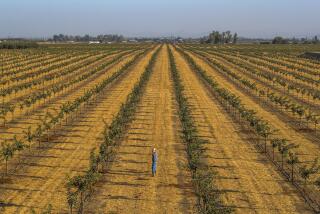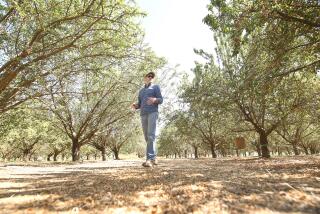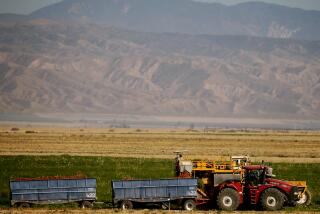Almonds are no longer villains — or scapegoats — of the drought

Watch Califonia almonds being harvested -- a magical sight.
- Share via
reporting from FIREBAUGH, Calif. — Off in the distance, there’s a disturbance in the almond orchard. The ground is shaking, the trees are rustling.
Getting closer, you can hear a machine that sounds like a chain saw. Then the tree shaker comes into view; it’s a low, yellow contraption, with an enclosed cab and a long, rubber-tipped claw.
The driver, 31-year-old Luis Perez, moves surprisingly quickly from tree to tree. He extends the claw, grasps a trunk, then gives each tree a fierce shake.
Suddenly, it’s raining almonds. Hundreds of nuts in their husks pop off the trees and fall to the dirt. A cloud of dust rises and subsides. The engine revs, Perez moves to the next tree, and the next, and the next, seven or eight trees a minute.
The San Joaquin almond harvest. What a magical sight.
And what a strange year it’s been for the desirable little nut that is among the state’s most profitable, and maligned, crops.
The almond began the year as the bad boy of the California drought, the water-sucking export responsible for your brown lawn, your abbreviated showers, your dingy toilet.
A nearly meaningless statistic — that each almond requires 1.1 gallons of water to produce — became the single fact about the drought that every Californian mastered. (Most fruit and nut trees use similar amounts of water.)
Almond farmers were taken aback, and slow to respond.
In the last few months, though, the narrative has shifted. Instead of pointing fingers at products perceived to be water hogs, Californians are more likely to be congratulating themselves on their excellent conservation efforts.
They understand viscerally, for perhaps the first time, how wasteful they’ve been. (When the governor demanded a 25% cutback in residential water use, some were outraged that he didn’t touch agricultural allotments. But many farmers had already experienced drastic cutbacks and have made big strides in conservation.)
Also, an ad campaign produced by the California Almond Board extolling the conservation practices of its farmers aired on public radio stations in Los Angeles and San Francisco and on talk radio stations in Sacramento. It was a pretty good, if somewhat belated, move.
More important, it seemed to hush the almond haters.
“They’ve put almonds into perspective,” said Joe Del Bosque, a nut farmer also known for his organic cantaloupes. We were sitting in his stuffy office, a double-wide trailer, just off Interstate 5 near Firebaugh. “Almonds aren’t giant, water-hogging things. They are a good crop, and good food.”
::
I met Del Bosque in May, when the California Almond Board invited me to join its annual informational tour for policymakers and water officials. Del Bosque was one of the hosts. After I wrote about him in June, he was inundated by reporters looking to personify the agricultural aspect of our historic four-year drought.
In the last few months, he has squired around news crews from all over — Scandinavia, Britain, France, Belgium. “The Europeans,” he said, “are incredibly concerned about their almonds.”
If you met him, you’d understand why he’s such a draw. He’s a family farmer, mellow, knowledgeable and utterly devoted not just to his almond and melon crops, but to his workers. (His wife and business partner, Maria Gloria, was a migrant worker as a child. And Del Bosque is a former chairman of AgSafe, a nonprofit organization whose mission is injury prevention among farmworkers.)
He doesn’t usually play this up, but Del Bosque is also the only farmer on the California Water Commission, a nine-member, governor-appointed group that advises the director of the Water Resources Department. Right now, the commission is grappling with how to allocate billions of dollars approved by voters last November for water storage projects.
On Wednesday, fulfilling a promise he made in early summer, he took me to see the almond harvest, which was earlier than usual, because of warmer-than-normal temperatures in March and April.
::
There’s nothing better than hanging out with a farmer.
As we bounced along dirt roads bordering irrigation canals in his SUV, Del Bosque reminisced about water skiing as a kid — by tying the ski rope to a truck driving fast along the banks.
We watched the shaker, then plucked almonds off the ground, snapped off the shells and ate them. At one of his other fields, he picked a cantaloupe, then sliced me a piece of the sweetest, most flavorful melon I’ve ever tasted.
This year, Del Bosque thinks he’ll have a decent almond crop, though the nuts may be a bit smaller than usual. That matters, since bigger almonds fetch a higher price per pound. (Buyers care about size, not taste.)
The high cost of water has sliced deeply into his profits.
In 2014, according to the U.S. Department of Agriculture, California almond orchards yielded 2,150 pounds per acre and sold for $3.50 a pound. That’s revenue of about $7,525 per acre.
Water, fertilizer and labor used to total about $3,000 per acre of almonds. With the price of water soaring, Del Bosque figures his total cost per acre this year at about $7,000, enough to turn a profit, but not like wetter times.
“If people think we are cutting a fat hog, well, by the time we pay for this water, we aren’t,” he said.
Still, he’s pleased that the demonized almond seems to have regained its halo.
But we still don’t have rain and the Sierra snow pack is anemic. Next year, we may need a new drought scapegoat. Maybe we should pick on pistachios. I hear one of those little things sucks up three-quarters of a gallon of water. Scandalous!
Twitter: @AbcarianLAT
MORE ON CALIFORNIA DROUGHT
Record heat, power outages, flood threats across Southern California
Salinas Valley’s thriving crops mask fears over the area’s lone water source
Drought is no reason to ease environmental protections, California voters say
More to Read
Sign up for Essential California
The most important California stories and recommendations in your inbox every morning.
You may occasionally receive promotional content from the Los Angeles Times.











